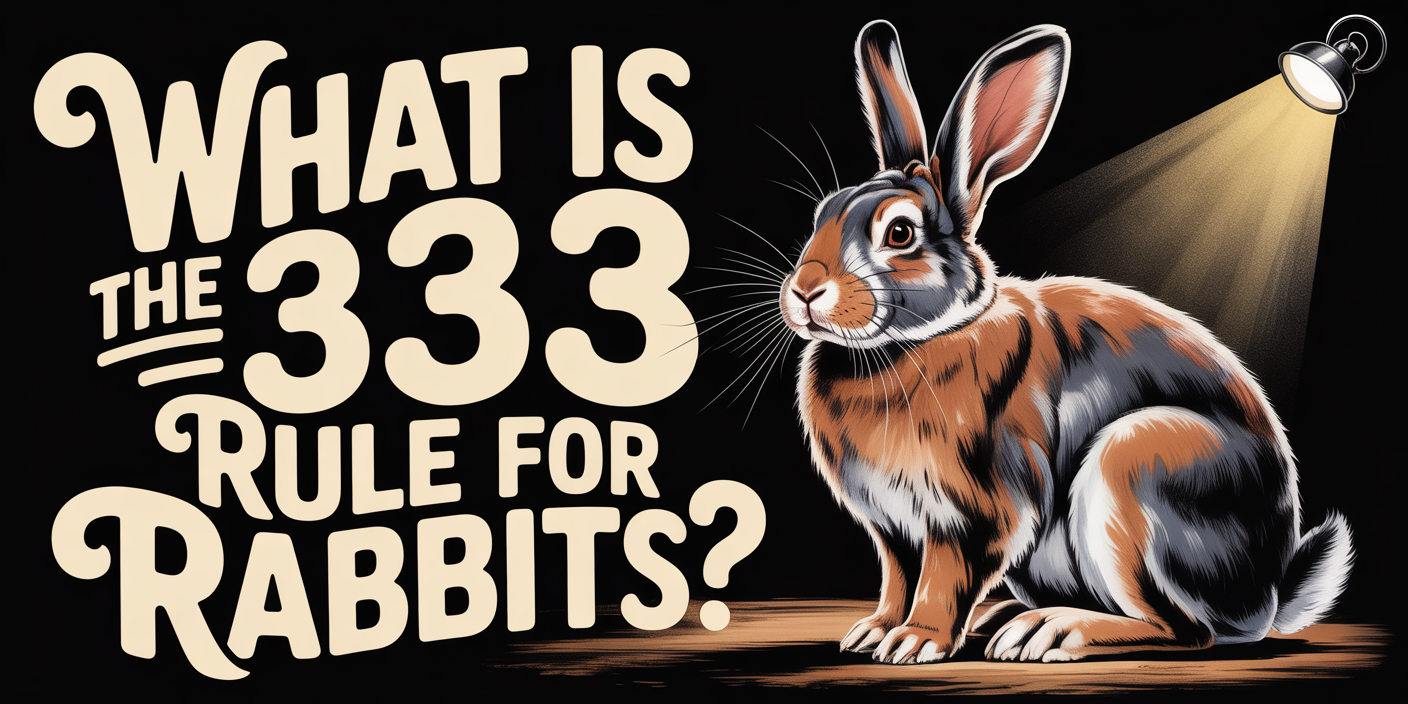The 3-3-3 rule for rabbits describes how they adjust to new environments: 3 days to decompress, 3 weeks to settle, and 3 months to feel secure. Originally used in rabbit rescue, this timeline also helps explain wild rabbit behavior after relocation or removal.
If you’ve ever spotted a rabbit calmly nibbling your grass or digging near your deck, you’re not alone. These fluffy intruders might look harmless, but they’re known for turning quiet yards into underground nesting zones faster than you’d expect. Homeowners often assume rabbits will just move along, but without understanding how rabbits think, you could end up dealing with repeat visits.
That’s where the 3-3-3 rule for rabbits comes in. While it originally came from rabbit rescues, it offers surprising insight into wild rabbit behavior too. At AAAC Wildlife Removal, we use this rule to understand how rabbits adjust to new environments, which helps us plan smarter, more humane removal strategies that actually work long-term.
What Is the 3-3-3 Rule for Rabbits?
The 3-3-3 rule is a behavioral timeline originally used in rabbit rescue circles to describe how long it takes a rabbit to adjust to a new home. It breaks down like this: 3 days to decompress, 3 weeks to settle in, and 3 months to feel secure. This concept was meant to guide pet owners through the early stages of rabbit adoption, but it turns out wild rabbits follow similar patterns when faced with new environments.
So why does this matter to homeowners dealing with rabbit problems? Because it gives you a roadmap. If a rabbit has been relocated or scared off, it may still linger nearby, attempt to return, or try nesting again within that familiar adjustment window. Understanding these behavior cycles helps explain why short-term fixes like noise or fencing don’t always work the first time.
At AAAC Wildlife Removal, we treat this rule as more than a rescue tool, it’s a behavior-based model for humane removal and long-term prevention. It helps us anticipate what a rabbit might do next and create removal strategies that go beyond “catch and release.” This isn’t just about relocating an animal, it’s about making sure it doesn’t come back.
How the 3-3-3 Rule Applies to Wild Rabbits in Your Yard
When wild rabbits are forced out of a familiar space, either by trapping, loud deterrents, or landscape changes, they don’t immediately disappear for good. The 3-3-3 rule gives us a rough timeline of how they mentally and physically respond to this disruption. Within the first 3 days, they may hover near the old site, confused and stressed, often returning at night to check if the coast is clear. During this phase, they’re still tied to scent trails and landmarks.
By the 3-week mark, rabbits will have either tested your property again or started adjusting to a new area. This is when you might notice fresh digging, scat, or fur even after thinking they were “gone.” Rabbits are habitual and cautious, they slowly rebuild trust in an area before fully committing to nesting again. Their goal is to reclaim what feels safe, especially if your yard still provides cover, food, or access to water.
Then comes the 3-month window. If a rabbit feels your yard is still a viable habitat, it may fully reintegrate, bring mates, and start nesting all over again. This is why a one-time scare tactic or removal effort often falls short. You’re not just removing a rabbit; you’re working against a timeline hardwired into its survival instincts.
Rabbit Removal Isn’t Just Trap-and-Go: It’s Behavioral
Traps might catch a rabbit, but they don’t solve the deeper issue: your property already feels safe to them. That’s why understanding rabbit psychology is crucial. Rabbits don’t just act on instinct, they build routines, follow scent trails, and revisit areas they’ve mapped out mentally. Ignoring that leads to a revolving door of rabbit visits.
AAAC Wildlife Removal approaches rabbit problems with a behavior-based strategy. Instead of just relocating an animal, we disrupt the pattern that brought it there in the first place. That means thinking beyond hardware and focusing on why your property attracts them.
Here’s what makes the difference:
- Territorial memory: Rabbits remember locations with food, shelter, and minimal threat. If not disrupted, they’ll try returning even after removal.
- Nesting behavior: A rabbit may abandon a nest temporarily, especially if scared, but often returns if the spot still “feels right.”
- Scent loyalty: Rabbits use scent trails to navigate and mark safe zones. These trails linger long after the rabbit is gone.
- Stress cycles: A removed rabbit may roam nearby for weeks before deciding to resettle or test old territory again.
By addressing behavioral patterns, not just rabbit presence, we create long-term deterrents that actually stick. That’s the key to keeping your yard rabbit-free, not just today, but three months from now.
Using the 3-3-3 Insight to Prevent Rabbits from Returning
The 3-3-3 rule tells us that rabbits don’t disappear instantly, they reevaluate, test, and return if your property still checks their boxes. This gives homeowners a valuable window to act strategically during each behavioral phase. The key isn’t just removal, it’s reprogramming your yard to feel unfamiliar and unsafe during their decision period.
Below are three strategic areas to focus on, each tied to the rabbit’s behavior timeline:
Disrupting Comfort During the First 3 Days
Rabbits hover nearby after removal, waiting for a sign it’s safe to come back. This is when you need to shake up their comfort zone.
- Remove shelter: Clear brush piles, wood stacks, and tall grass immediately after removal.
- Eliminate food sources: Pick up fallen fruit, cover garden beds, and use fencing around leafy plants.
- Use scent deterrents: Apply predator urine or natural repellents near old nesting spots.
- Block reentry points: Close gaps under decks, sheds, or porches with wire mesh.
These changes confuse the rabbit’s mental map and discourage early return attempts.
Reinforcing the Message During the First 3 Weeks
By this time, the rabbit may start poking around again—especially at dusk or dawn. Your job is to keep reinforcing the idea that your property is no longer a safe bet.
- Rotate deterrents: Motion-activated sprinklers or sound devices can surprise repeat visitors.
- Refresh scent markers: Reapply repellents weekly to keep the area unpleasant.
- Introduce movement: Hanging aluminum foil or pinwheels near the nest site adds visual disruption.
- Recheck access points: Rabbits are persistent, so seal any newly dug areas or holes.
Consistency during this period stops them from reclaiming old territory.
Creating Long-Term Discomfort Over the Next 3 Months
If a rabbit doesn’t feel safe during this phase, it’ll permanently shift its nesting behavior elsewhere. This is your chance to close the chapter for good.
- Landscape intentionally: Choose plants rabbits avoid, like lavender, rosemary, or marigold.
- Gravel or mulch beds: These make digging uncomfortable and uninviting.
- Encourage natural predators: Owls and hawks can be attracted with perches or nesting boxes.
- Schedule routine checks: Even small signs like droppings or scratches can alert you early.
Treat your yard like a “don’t come back” zone, not a “maybe later” spot.
The 3-3-3 Rule Is About Respecting Rabbit Nature
Wild rabbits aren’t just wandering pests, they’re pattern-driven survivors with a strong sense of routine. The 3-3-3 rule gives us a unique lens to understand how they respond to stress, change, and new environments. When you treat rabbit removal as a behavioral challenge instead of a one-time fix, your chances of keeping them away go way up.
At AAAC Wildlife Removal, we don’t just react to rabbit problems, we anticipate them. By using behavior-based insights like the 3-3-3 rule, we help homeowners stay one step ahead and create spaces that rabbits simply won’t return to. It’s humane, it’s smart, and it works.
Call AAAC Wildlife Removal: Let’s Outthink the Rabbits
Rabbits might be cute, but dealing with them requires more than guesswork and garden fences. At AAAC Wildlife Removal, our Rabbit Game Plan uses behavioral science, including the 3-3-3 rule, to remove them humanely and keep them from coming back. We don’t just trap, we think like rabbits, and that makes all the difference.
If you’re tired of chewed plants, backyard burrows, or a nest that won’t go away, it’s time to call in pros who understand what’s really going on. Let us inspect, remove, and rabbit-proof your property for good.
Call AAAC Wildlife Removal today and take the smart, humane approach to rabbit control.




